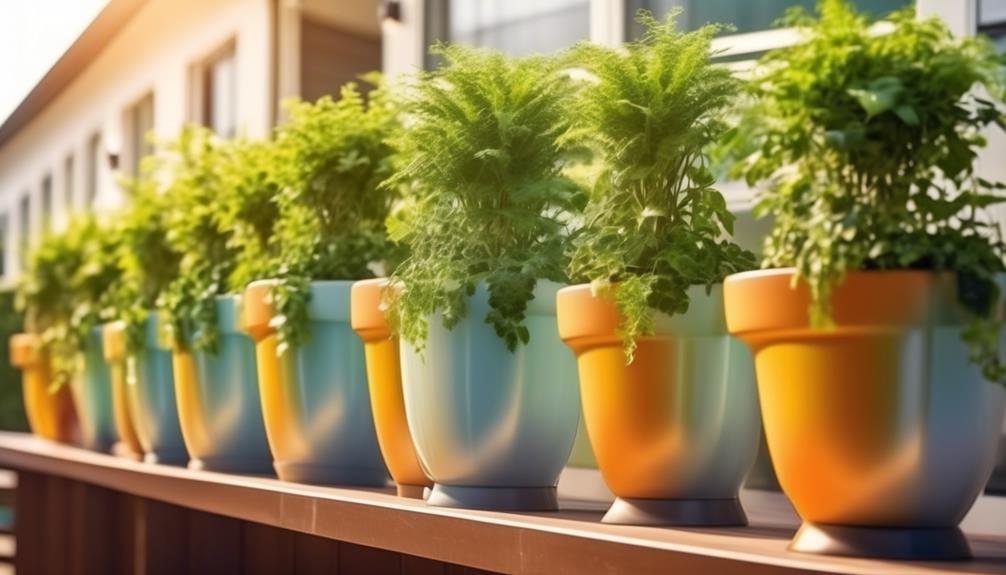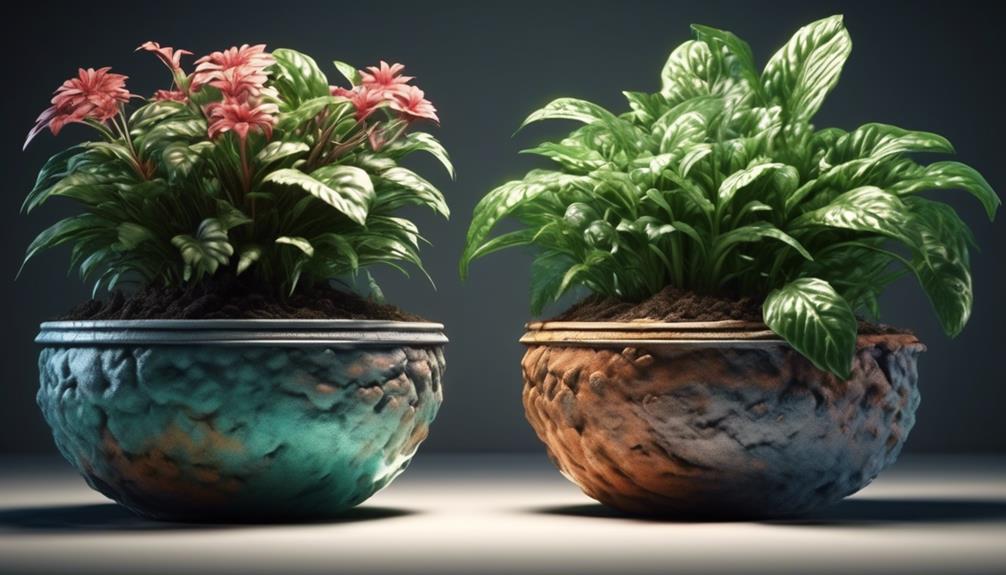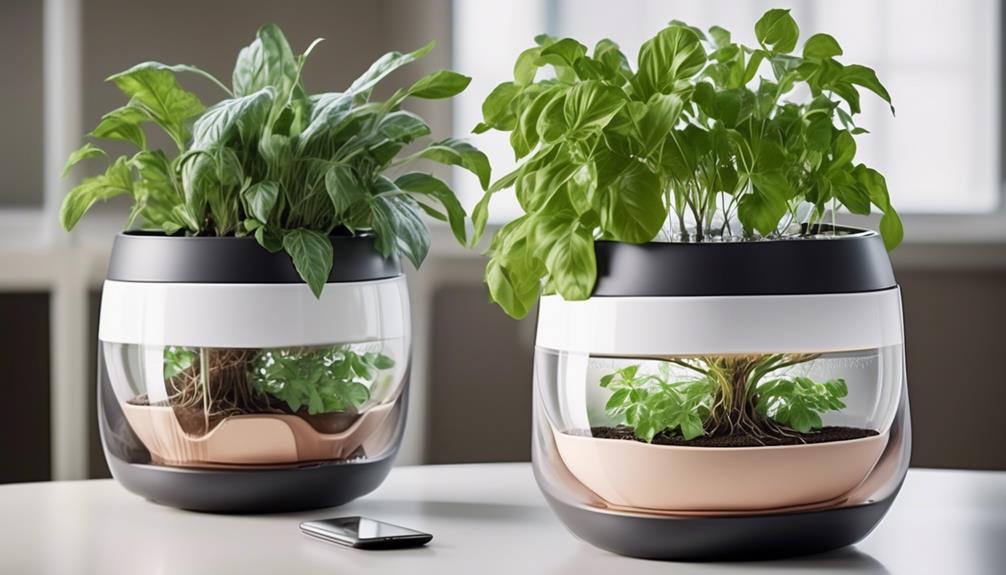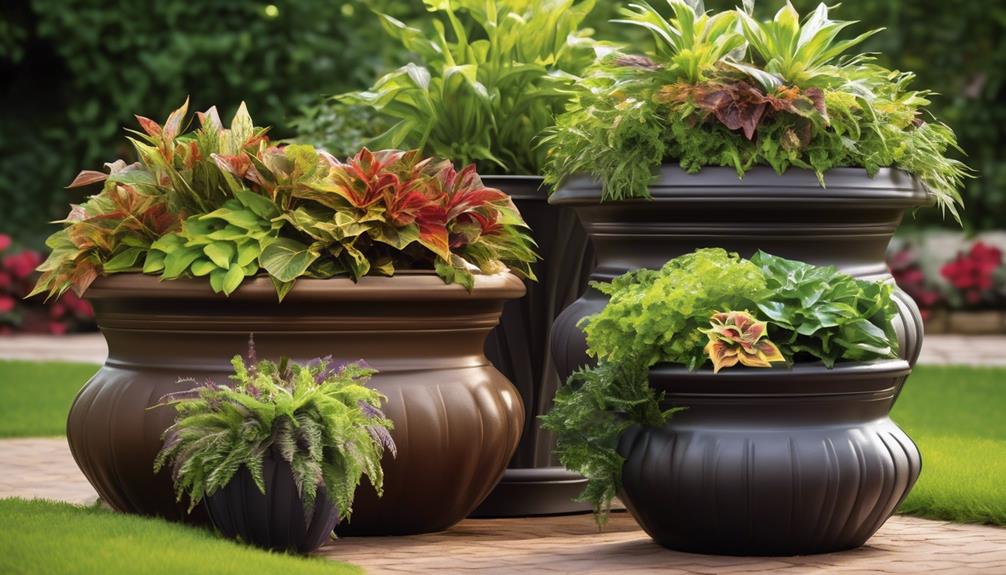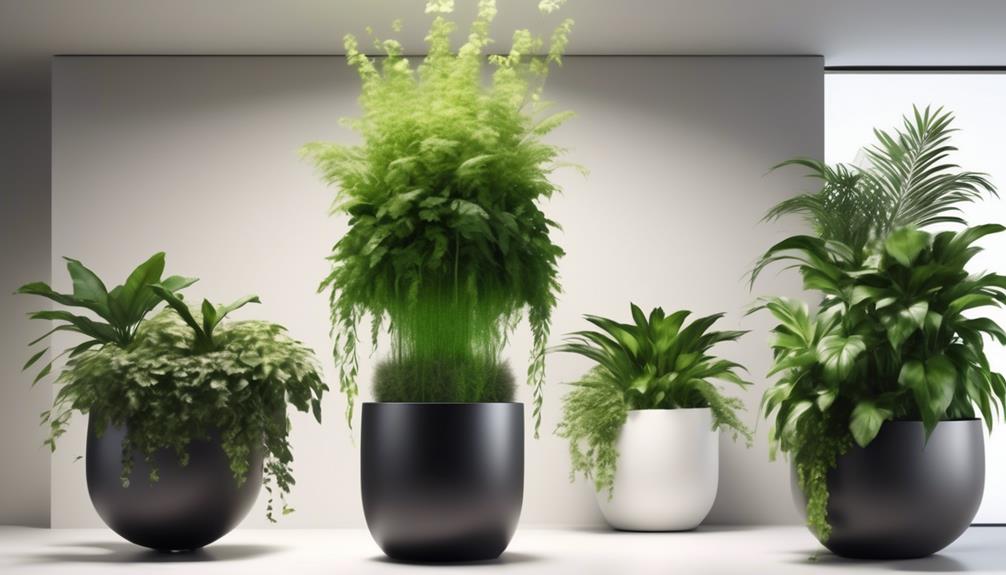We have all experienced the struggle of making sure our outdoor plants receive enough water. It is an ongoing challenge, especially during the intense heat of summer or the freezing cold of winter.
But what if there was a way to alleviate this struggle, allowing us to enjoy our greenery without the constant worry of over or under-watering? Outdoor self-watering plant pots offer a potential solution to this common dilemma. These innovative pots claim to provide a consistent water supply to your plants, making it easier to maintain their health and vibrancy.
But do they really live up to the hype? Let's explore the benefits, considerations, and practical tips for utilizing these pots to enhance our outdoor spaces.
Key Takeaways
- Outdoor self-watering plant pots provide a convenient and efficient way to ensure optimal hydration for plants.
- Choosing the right self-watering pot size is important to accommodate growth without restricting roots and ensure optimal plant health.
- Proper planting and maintenance, including using well-draining potting mix and monitoring moisture levels, are essential for the health of plants in self-watering pots.
- There are different types of self-watering systems available, such as hydroponic systems and drip irrigation, that can be chosen based on individual needs and promote plant health.
Benefits of Outdoor Self-Watering Plant Pots
Outdoor self-watering plant pots provide a convenient and efficient way to ensure optimal hydration for plants without the need for constant monitoring and manual watering. These pots offer a significant advantage in watering efficiency by utilizing a reservoir system to supply a consistent level of moisture to the plants. This prevents under or overwatering, which can be detrimental to plant health. The self-watering mechanism allows for a steady uptake of water by the plants' roots, promoting healthy growth and reducing the risk of water stress.
Choosing the Right Self-Watering Pot Size
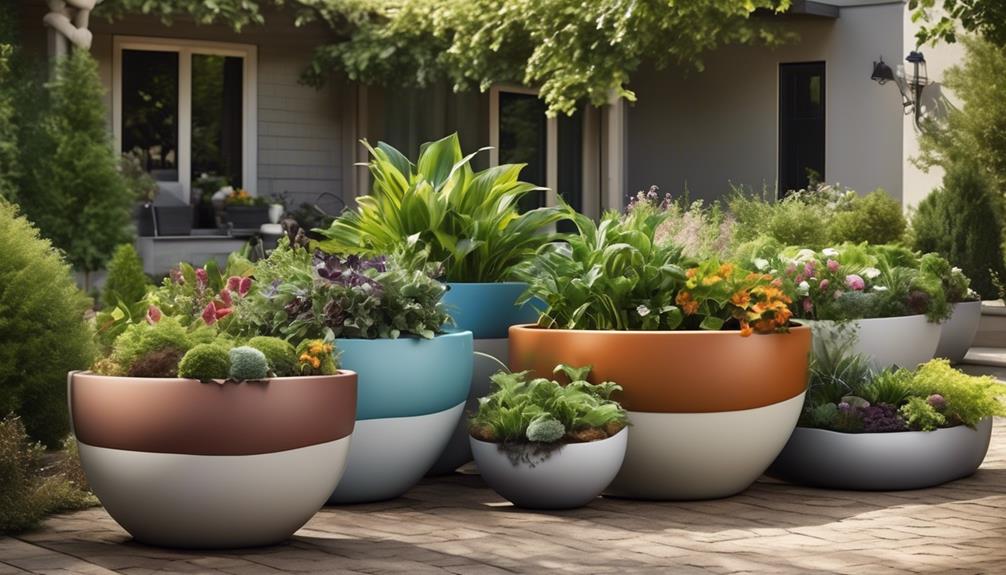
When selecting a self-watering pot size, consider the specific needs of the plant species and the environmental conditions in which it will be placed. Choosing the right pot size is crucial for the overall health and growth of your plants.
Here are a few key points to consider:
- Watering Frequency: Assess the watering needs of the plant species you intend to grow. Some plants require more water, while others thrive with less frequent watering. Select a pot size that aligns with the plant's specific watering requirements to ensure optimal growth and health.
- Plant Compatibility: Different plant species have varying root systems and space requirements. It's essential to choose a pot size that provides ample room for the roots to grow and expand, promoting healthy development. Consider the mature size of the plant and select a pot that accommodates its growth without restricting the root system.
- Environmental Conditions: Take into account the environmental factors such as sunlight exposure and humidity levels in the area where the pot will be placed. These conditions can influence the watering needs of the plant and impact the size of the pot required for optimal growth.
Choosing the right self-watering pot size based on these factors will contribute to the overall well-being of your plants and ensure successful cultivation.
Tips for Proper Planting and Maintenance
To ensure successful growth and maintenance of your plants in self-watering pots, it's essential to follow proper planting and maintenance techniques.
When planting in self-watering pots, it's crucial to choose the right soil moisture. Use a well-draining potting mix to prevent waterlogging, which can lead to root rot. Additionally, it's important to consider the sunlight exposure for your plants. Place sun-loving plants in areas with ample sunlight, while shade-loving plants should be positioned in areas with partial shade.
Regularly monitor the moisture levels in the pots to ensure that the soil remains consistently moist but not waterlogged. Adjust the watering frequency based on the plant's needs and the environmental conditions.
Maintenance is equally important for the health of your plants in self-watering pots. Regularly check for any signs of pests, diseases, or nutrient deficiencies. Prune the plants as needed to promote healthy growth and remove any damaged or diseased parts.
Periodically clean the self-watering system to prevent clogs and ensure proper functioning. By following these tips for proper planting and maintenance, you can help your plants thrive in self-watering pots.
Types of Self-Watering Systems
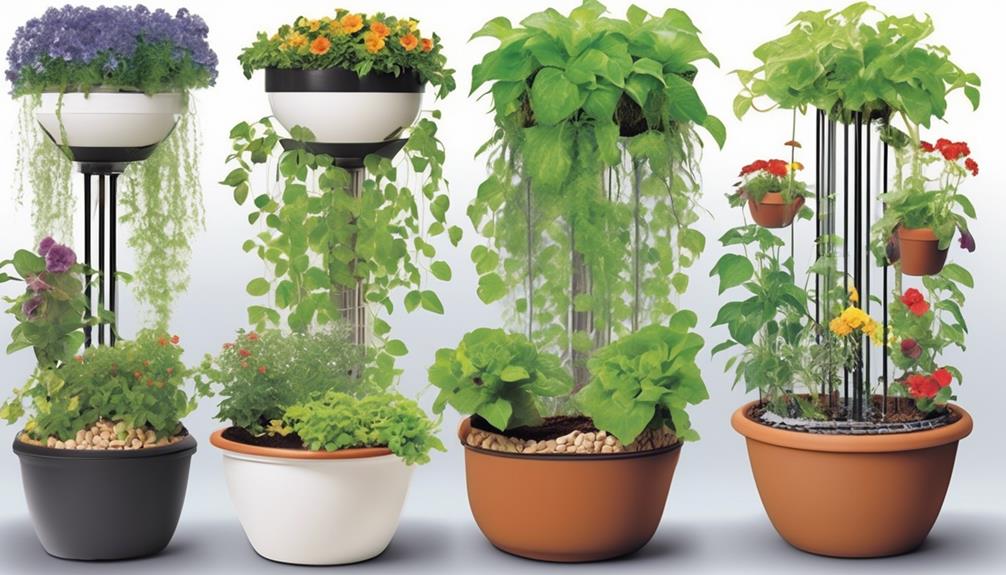
Choosing the right type of self-watering system is crucial for maintaining the proper soil moisture levels mentioned previously, ensuring the health and vitality of your plants. There are several types of self-watering systems available, each with its unique features and benefits.
- Hydroponic systems: These advanced systems provide a highly efficient way to deliver water and nutrients directly to the plant roots. They're ideal for individuals who want precise control over the growing conditions of their plants, ensuring optimal growth and health.
- Drip irrigation: This system delivers water slowly and directly to the plant's roots, mimicking the natural process of rainfall. It's an excellent choice for individuals who desire a low-maintenance watering solution while promoting water conservation.
- Wicking method: This simple yet effective method utilizes capillary action to draw water from a reservoir into the soil, ensuring consistent moisture levels. It's perfect for those who seek an easy-to-use self-watering system that promotes even hydration for their plants.
Understanding the different types of self-watering systems allows you to select the one that best suits your needs, helping you provide the best care for your beloved plants.
Enhancing Outdoor Spaces With Self-Watering Pots
Enhancing outdoor spaces with self-watering pots significantly improves the sustainability and health of the plants while reducing the maintenance required for optimal growth. Creative design and strategic plant placement play crucial roles in maximizing the benefits of self-watering pots. Through thoughtful design and strategic plant placement, outdoor spaces can be transformed into thriving green environments that require minimal upkeep.
| Creative Design | Plant Placement |
|---|---|
| Unique shapes and materials can enhance the aesthetic appeal of outdoor spaces, adding a touch of elegance and style. | Placing plants strategically in self-watering pots allows for better utilization of space, creating visually appealing arrangements and maximizing plant health. |
| Incorporating self-watering pots into the design of outdoor spaces provides innovative solutions for sustainable plant care. | By placing self-watering pots in areas with optimal sunlight and water access, plants can thrive with minimal effort, enhancing the overall ambiance of the outdoor space. |
| Utilizing different sizes and heights of self-watering pots creates visual interest and dimension in outdoor areas. | Strategic placement of self-watering pots allows for the creation of natural barriers or focal points within the outdoor space, enhancing the overall design. |
Frequently Asked Questions
How Often Should I Refill the Water Reservoir in a Self-Watering Plant Pot?
We should monitor the water level regularly to determine the refilling frequency. Factors like plant type, soil type, and environmental conditions influence the rate of water consumption.
It's important to understand the watering system and the materials of the plant pot to make an informed decision. By observing the water level and adjusting the refill frequency accordingly, we can ensure that the plants receive the appropriate amount of water for healthy growth.
Can I Use Self-Watering Plant Pots for All Types of Outdoor Plants, Including Succulents and Cacti?
We select the right pot for each plant to ensure proper growth. Self-watering benefits provide a consistent water supply, but it's crucial to consider the specific needs of outdoor plants.
Succulents and cacti require well-draining soil and less frequent watering, so self-watering pots may not be suitable.
It's essential to understand the individual requirements of each plant species to make the best choice for their growth and health.
Are Self-Watering Plant Pots Suitable for Extreme Weather Conditions, Such as Extreme Heat or Cold?
In extreme weather conditions, like extreme heat or cold, self-watering plant pots are incredibly durable and reliable. They help regulate watering frequency, ensuring plants receive consistent moisture.
Maintenance is minimal, making them ideal for outdoor environments. The design is scientifically proven to support plants even in harsh climates.
Do Self-Watering Plant Pots Come With a Warranty or Guarantee?
Yes, self-watering plant pots often come with warranty coverage to ensure customer satisfaction.
The warranty terms may vary by manufacturer and model, so it's important to review the specific details before making a purchase.
This can provide peace of mind and assurance that the product is backed by the company in case of any issues.
It's a great way to protect your investment and ensure long-term satisfaction with your purchase.
Can Self-Watering Plant Pots Be Used Indoors as Well as Outdoors?
Yes, self-watering plant pots can be used indoors as well as outdoors. They provide a convenient way to keep plants healthy and hydrated, whether inside or outside. The benefits of using self-watering pots indoors include reducing the frequency of watering and maintaining consistent moisture levels. However, one drawback is the potential for overwatering if not monitored carefully.
Outdoors, they offer the same benefits, but may need more frequent refilling due to higher temperatures and sunlight exposure.
How Effective Are DIY Self-Watering Plant Pots Using Soda Bottles Compared to Outdoor Self-Watering Plant Pots?
DIY self-watering plant pots using soda bottles are a budget-friendly option, but outdoor self-watering plant pots offer better durability and aesthetics. While soda bottle planters require more frequent refilling, outdoor self-watering pots can sustain plants for longer periods, making them more effective for outdoor use.
Conclusion
In conclusion, outdoor self-watering plant pots offer a convenient and efficient way to keep plants hydrated without the need for constant monitoring and watering.
By utilizing innovative self-watering systems, these pots provide a sustainable and low-maintenance solution for maintaining healthy plants in outdoor spaces.
With the right pot size and proper planting techniques, anyone can enhance their outdoor environment with vibrant and thriving greenery, making gardening a breeze.

